
Equidae is the taxonomic family of horses and related animals, including the extant horses, asses, and zebras, and many other species known only from fossils. All extant species are in the genus Equus, which originated in North America. Equidae belongs to the order Perissodactyla, which includes the extant tapirs and rhinoceros, and several extinct families.

Odd-toed ungulates, mammals which constitute the taxonomic order Perissodactyla, are animals—ungulates—who have reduced the weight-bearing toes to three or one of the five original toes. The non-weight-bearing toes are either present, absent, vestigial, or positioned posteriorly. By contrast, the even-toed ungulates bear most of their weight equally on four or two of the five toes: their third and fourth toes. Another difference between the two is that odd-toed ungulates digest plant cellulose in their intestines, rather than in one or more stomach chambers as even-toed ungulates, with the exception of Suina, do.
Condylarthra is an informal group – previously considered an order – of extinct placental mammals, known primarily from the Paleocene and Eocene epochs. They are considered early, primitive ungulates. It is now largely considered to be a wastebasket taxon, having served as a dumping ground for classifying ungulates which had not been clearly established as part of either Perissodactyla or Artiodactyla, being composed thus of several unrelated lineages.

Eohippus is an extinct genus of small equid ungulates. The only species is E. angustidens, which was long considered a species of Hyracotherium. Its remains have been identified in North America and date to the Early Eocene.
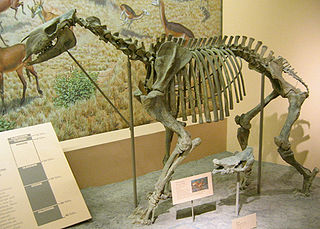
Chalicotheres are an extinct clade of herbivorous, odd-toed ungulate (perissodactyl) mammals that lived in North America, Eurasia, and Africa from the Middle Eocene until the Early Pleistocene, existing from 48.6 to 1.806 mya. They are one of the five major radiations of perissodactyls, with three groups living, and two extinct.

Mesaxonia is a clade of ungulates whose weight is distributed on the third toe on all legs through the plane symmetry of their feet. For a while it was often seen to only contain the order Perissodactyla. Recent work in morphological cladistics and ancient DNA suggests that several extinct lineages, like the Desmostylia and some of the South American ungulates of Meridiungulata are related to the perissodactyls.
Birbalomys is an extinct genus of rodent from Asia.
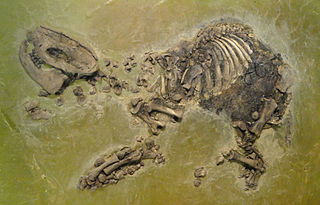
Lophiodon is an extinct genus of mammal related to chalicotheres. It lived in Eocene Europe between 52 to 38 million years ago, and was previously thought to be closely related to Hyrachyus.
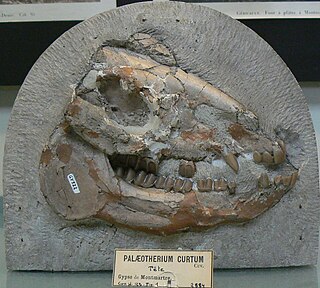
Palaeotheriidae is an extinct family of herbivorous perissodactyl mammals related to equids. They ranged across Europe and Asia from the Eocene through to the early Oligocene 55–33 Ma, existing for approximately 22 million years.
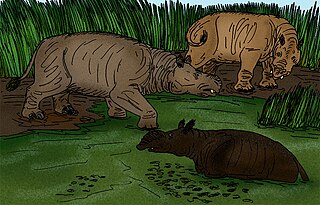
Amynodontidae is a family of extinct perissodactyls related to true rhinoceroses. They are commonly portrayed as semiaquatic hippo-like rhinos but this description only fits members of the Metamynodontini; other groups of amynodonts like the cadurcodontines had more typical ungulate proportions and convergently evolved a tapir-like proboscis.
Lophiaspis is an extinct genus of early perissodactyl endemic to southern Europe during the Early to Middle Eocene, living from 55.8 to 37.2 Ma. Remains have been found from France, Spain, and Portugal.
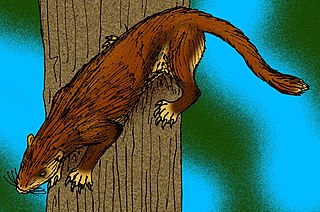
Hyopsodontidae is an extinct family of primitive mammals from the order Condylarthra, living from the Paleocene to the Eocene in North America and Eurasia. Condylarthra is now thought to be a wastebasket taxon; hyopsodontids have occasionally been speculated to be related to Afrotheria, but the most recent consensus is that they are related to Perissodactyla. Analysis of the inner ear shows shared characteristics with the Equoidea ; they may be a basal ungulate group near to perissodactyls.
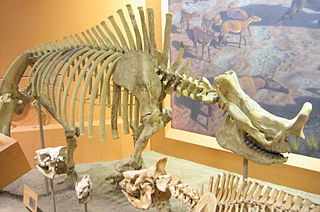
Brontotheriidae is a family of extinct mammals belonging to the order Perissodactyla, the order that includes horses, rhinoceroses, and tapirs. Superficially, they looked rather like rhinos, although they were actually more closely related to horses; Equidae and Brontotheriidae make up the suborder Hippomorpha. They lived around 56–34 million years ago, until the very close of the Eocene.

Homogalax is an extinct genus of tapir-like odd-toed ungulate. It was described on the basis of several fossil finds from the northwest of the United States, whereby the majority of the remains come from the state of Wyoming. The finds date to the Lower Eocene between 56 and 48 million years ago. In general, Homogalax was very small, only reaching the weight of today's peccaries, with a maximum of 15 kg. Phylogenetic analysis suggests the genus to be a basal member of the clade that includes today's rhinoceros and tapirs. In contrast to these, Homogalax was adapted to fast locomotion.

Pliolophus is an extinct equid that lived in the Early Eocene of Britain.
Urtinotherium is an extinct genus of paracerathere mammals. It was a large animal that was closely related to Paraceratherium, and found in rocks dating from the Late Eocene to Early Oligocene period. The remains were first discovered in the Urtyn Obo region in Inner Mongolia, which the name Urtinotherium is based upon. Other referred specimens are from northern China.
Olbitherium is an extinct mammal of the order Perissodactyla from the early Eocene epoch of Shandong, China.

The San Jose Formation is an Early Eocene geologic formation in the San Juan Basin of New Mexico and Colorado.
Cambaytherium is an extinct genus of placental mammals in the family Cambaytheriidae whose fossils were found in an open pit coal mine located in Gujarat, India. The mine was a treasure trove full of teeth and bones, over 200 of which were identified as belonging to Cambaytherium thewissi. The fossils were dated to the Early Eocene, 54.5 million years ago, making them slightly younger than the oldest known fossils belonging to the order Perissodactyla.
Cambaytheriidae is a family of primitive four or five-toed ungulates native to the Indian subcontinent. They lived during the Early Eocene epoch and are distinguished by the presence of bunodont teeth suitable for eating tough vegetation. They are related to, but distinct from, the early perissodactyls, and may also be closely related to the anthracobunids as a sister group to the Perissodactyla.













